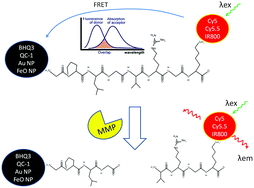Optical imaging offers high sensitivity and portability at low cost. The design of an optimal “activatable” imaging agent could greatly decrease the background noise and increase specificity of the signal. Five different molecules have been used to quench basal fluorescence of an enzyme substrate labeled with Cy5, Cy5.5 or IR800 at a distance of 8 amino acids (32 Å): a 6 nm gold nanoparticle (NP), a 20 nm and a 30 nm iron oxide (FeO) NP, the black hole quencher BHQ-3 and the IRdye quencher QC-1. The quenching efficiencies were 99% for QC1–IR800, 98% for QC1–Cy5.5, 96% for 30 nm FeO NP–Cy5.5, 89% for BHQ3–Cy5, 84% for BHQ3–Cy5.5, 77–90% for 6 nm gold NP–Cy5.5, depending on the number of dyes around the NP, 79% for 20 nm FeO NP–Cy5.5 and 77% for Cy5.5–Cy5. Signal activation upon cleavage by the matrix metalloproteinase MMP9 was proportional to the quenching efficiencies, ranging from 3-fold with Cy5.5–Cy5 to 67-fold with QC1–IR800. This independent work reports on the properties of the dyes and quenchers explaining the superior performance of QC-1 and 30 nm FeO NPs.

You have access to this article
 Please wait while we load your content...
Something went wrong. Try again?
Please wait while we load your content...
Something went wrong. Try again?


 Please wait while we load your content...
Please wait while we load your content...